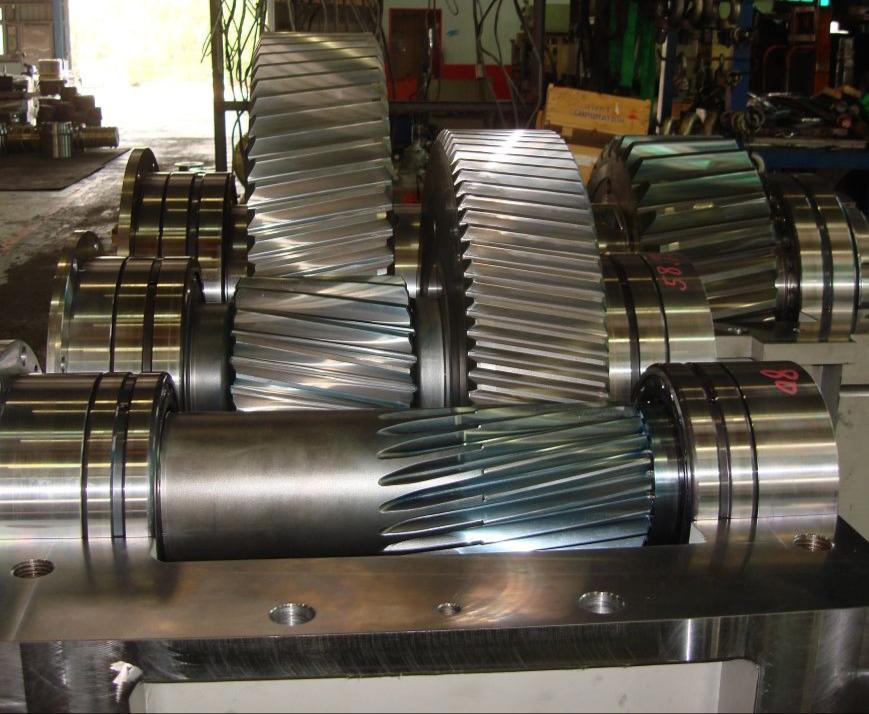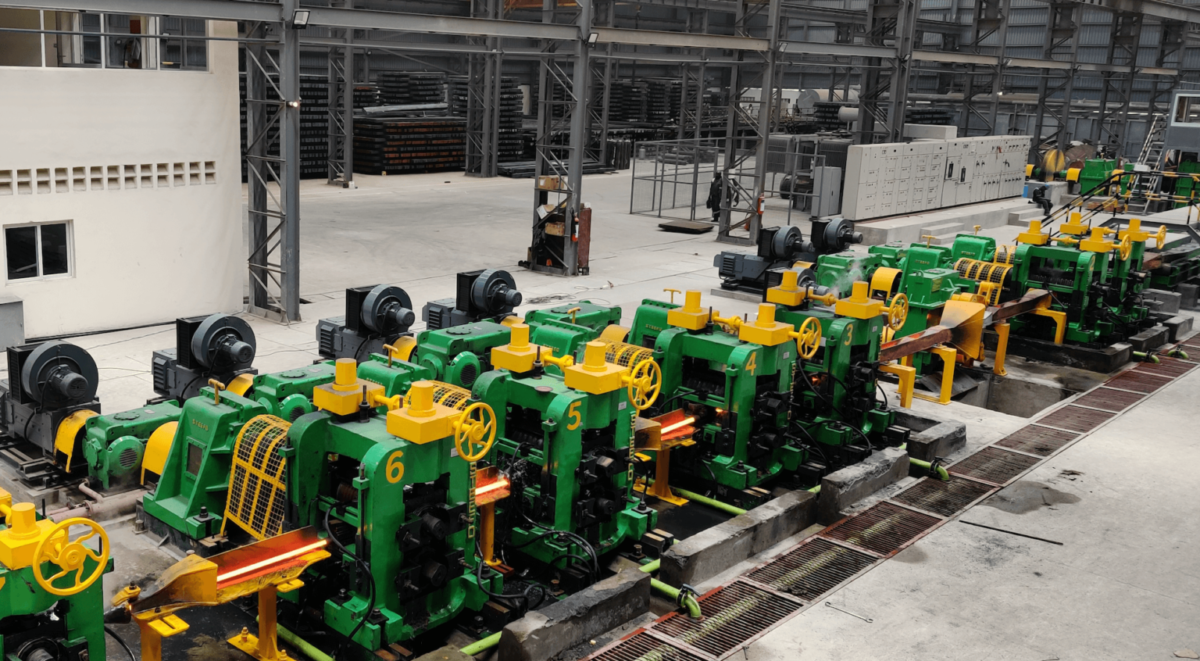In the competitive landscape of rolling mills, maintaining optimal product quality while ensuring operational efficiency is crucial. Cooling systems play a vital role in achieving these goals, as they affect the temperature and properties of finished products. Traditionally, rolling mills have relied on conventional cooling methods. However, with advancements in technology, automatic cooling beds have emerged as a modern solution. This article explores both systems, comparing their features, benefits, and drawbacks to help businesses make informed decisions.
Introduction to Traditional Cooling Systems
Traditional cooling systems in rolling mills primarily include methods like air cooling and water cooling. These systems have been the backbone of cooling processes for many years, owing to their simplicity and low initial investment.
Types of Traditional Cooling Methods
Air Cooling: This method relies on ambient air to cool down hot rolled products. It involves exposing the products to the environment, allowing heat to dissipate naturally. Although this method is straightforward, it can be influenced by weather conditions, affecting cooling rates.
Water Cooling: In this method, products are sprayed or immersed in water to accelerate cooling. It is generally more effective than air cooling, as water has a higher heat capacity, allowing for faster temperature reduction. However, it requires a robust water supply and may involve additional equipment to manage wastewater.
Pros:
- Simple Design: Traditional cooling systems are relatively easy to install and operate, making them accessible for many rolling mills.
- Lower Upfront Costs: The initial investment in traditional systems is typically lower than that for automatic cooling beds, making them an attractive option for smaller operations.
- Ease of Maintenance: With fewer complex components, traditional systems require less specialised maintenance, allowing for quicker repairs and reduced downtime.
Cons:
- Manual Intervention: Traditional cooling systems often necessitate human oversight to monitor temperatures and adjust processes. This reliance on manual labour can lead to inconsistencies.
- Uneven Cooling: The cooling process can be uneven, especially with air cooling, potentially leading to product defects such as warping or cracking.
- Potential Energy Inefficiency: Traditional systems may consume more energy over time due to inconsistent cooling, resulting in higher operational costs.
Introduction to Automatic Cooling Beds
Automatic cooling beds represent a significant advancement in the cooling process for rolling mills. These systems are designed to automate the cooling of hot-rolled products, improving efficiency and product quality.
What are Automatic Cooling Beds?
These are sophisticated systems that utilise a combination of automation and controlled cooling techniques. They facilitate the systematic movement of hot rolled bars through a cooling process, ensuring uniform temperature reduction.
How Automatic Cooling Beds Function in Rolling Mills
Automatic cooling beds operate through automated movement mechanisms that transport products from the mill to the cooling area. As the bars are conveyed, they pass through a cooling zone (Cooling using ambient temperature and natural cooling). This process allows for a consistent cooling rate, minimizing the risk of product defects.
Pros:
- Consistent Cooling: Automatic cooling systems provide uniform cooling across all products, enhancing overall product quality.
- Reduced Manual Labour: By automating the cooling process, businesses can minimise manual labour, allowing personnel to focus on more strategic tasks.
- Improved Product Quality: Consistent cooling leads to better mechanical properties and surface finishes, resulting in higher-quality products.
Cons:
- High Initial Investment: The upfront cost of purchasing and installing automatic cooling beds can be significant. This may pose a financial burden, especially for smaller operations.
Integration of Automation with Modern Industry 4.0 Technologies
The cooling beds can be integrated with Industry 4.0 technologies, such as IoT and AI. This integration allows for real-time monitoring, data analytics, and predictive maintenance, further optimising operations in rolling mills.
Automatic Cooling Beds vs. Traditional Cooling Systems
Cooling Efficiency
One of the most significant differences between automatic cooling beds and traditional cooling systems is their cooling efficiency.
Cooling Time and Uniformity
These cooling systems excel in cooling time and uniformity. The automated mechanisms ensure hot rolled products are cooled uniformly, significantly reducing thermal stresses. In contrast, traditional methods, especially air cooling, can lead to uneven temperature distribution. This inconsistency can result in defects like warping or cracking, impacting product quality.
Impact on Product Quality and Consistency
With automatic cooling beds, manufacturers experience fewer defects due to consistent cooling. Products cooled uniformly are less likely to undergo thermal stresses, leading to improved mechanical properties. In contrast, traditional systems can produce variable results, affecting product quality and consistency. Thus, the adoption of these cooling systems can enhance the overall reputation of a rolling mill‘s output, increasing customer satisfaction and trust.
Production Speed and Automation
Automation significantly influences production speed in rolling mills.
Reduction of Downtime and Manual Intervention
Automatic cooling beds minimize downtime through continuous operation and less manual intervention. Once set up, these systems can operate autonomously, transporting products through the cooling process without requiring constant oversight. This efficiency reduces production delays that often arise from manual handling and monitoring.
Comparison of Production Cycles
In a rolling mill using traditional cooling systems, the production cycle can be longer due to the need for manual checks and adjustments. Additionally, if operators notice issues, they must intervene, potentially halting production. Conversely, the cooling beds streamline the production cycle, allowing for quicker processing and greater throughput. This efficiency can result in significant time savings and increased production capacity.
Energy Efficiency
Energy consumption is a crucial factor in the operational costs of rolling mills.
Traditional Cooling Systems vs. Automatic Beds
Traditional cooling systems, particularly those relying on water or air, can consume considerable energy. For instance, water cooling requires a constant water supply, which not only involves energy use for pumping but also has environmental implications. In contrast, automatic cooling beds are designed for energy efficiency. Their systems utilise precise controls to minimize energy wastage, ensuring only the required amount of cooling is provided.
Sustainability and Cost Benefits
The energy efficiency of automatic cooling systems translates into lower operational costs. Companies can significantly reduce their energy bills, contributing to a more sustainable operation. Furthermore, by minimizing energy consumption, rolling mills enhance their environmental responsibility, aligning with global sustainability trends. This shift benefits the environment and also improves the company’s marketability to eco-conscious consumers and stakeholders.
Labour and Operational Costs
The labour dynamics in rolling mills also shift significantly with the adoption of automatic cooling beds.
Manual Labour Requirements
Traditional cooling systems often require a substantial workforce to manage cooling processes, monitor temperatures, and ensure product quality. This reliance on manual labour can lead to higher operational costs and potential inefficiencies. Conversely, automatic counterparts drastically reduce the need for manual labour. While the initial setup may require investment in automation, the long-term benefits include a leaner workforce, allowing for the reallocation of personnel to more critical tasks.
Long-term Cost Benefits
Over time, the cost savings from reduced labour and maintenance needs can be substantial. Lower labour costs combined with improved operational efficiency can lead to a significant reduction in overall production costs, making these systems financially advantageous in the long run.
Flexibility and Adaptability
Lastly, flexibility and adaptability are essential factors to consider when evaluating cooling systems.
Flexibility of Traditional Systems
Traditional cooling systems can be flexible in different rolling mill setups. They can be easily adjusted to accommodate various products and configurations. However, this flexibility often comes at the cost of efficiency and consistency.
Adaptability of Automatic Cooling Beds
Automatic cooling beds offer superior adaptability to various production requirements. They can be programmed to adjust cooling times based on different metal grades and bar sizes, ensuring optimal cooling for a range of products. This adaptability allows businesses to maintain high standards of quality across diverse product lines, enhancing their competitive edge in the market.
Challenges and Considerations When Switching to Automatic Cooling Beds
Transitioning to automatic cooling beds from traditional cooling systems involves several challenges and considerations that rolling mill businesses must evaluate.
Initial Cost Investment and ROI Analysis
The upfront investment for cooling beds can be significant. Businesses must conduct a thorough ROI analysis to ensure that long-term savings and efficiency gains justify this initial cost.
Integration Challenges with Existing Mill Infrastructure
Integrating automatic cooling beds with existing mill infrastructure can pose challenges. Modifications may be required to accommodate the new system, which could lead to temporary disruptions in production.
Maintenance and Troubleshooting of Automated Systems
While the cooling beds reduce manual labour, they require a different maintenance approach. Operators must be trained to troubleshoot and maintain the technology, which may differ from traditional systems.
Skillset Upgrades Required for Operators
To maximise the benefits of automatic cooling beds, operators will need skillset upgrades. Training programs should be implemented to ensure staff are well-versed in operating and maintaining the automated systems.
Frequently Asked Questions
1. How long does it typically take to see ROI when switching to automatic cooling beds?
The return on investment (ROI) for automatic cooling systems usually takes between one to three years. This timeframe can vary based on factors such as energy savings, reduced labour costs, and improved product quality. A detailed ROI analysis can help businesses forecast their specific payback period.
2. Can traditional cooling systems be upgraded to partially automate the process?
Yes, traditional cooling systems can often be upgraded to incorporate automation. Implementing automated temperature controls or sensor technology can improve efficiency while retaining the existing infrastructure. However, this may not provide the full benefits of a complete transition to automatic cooling.
3. How does automatic cooling handle different metal grades during production?
Automatic cooling beds are designed to adapt to various metal grades. These systems can be programmed to modify cooling times and methods based on specific material requirements. This flexibility ensures different products receive optimal cooling, maintaining quality and performance standards.
4. What are the key maintenance requirements for automatic cooling beds compared to traditional systems?
Automatic cooling beds require more specialised maintenance due to their complex components and automated controls. Key maintenance tasks include regular inspections of moving parts, software updates, and system calibrations. In contrast, traditional systems may require simpler routine maintenance, but they may need more frequent manual adjustments.
5. Can automatic cooling improve the safety conditions for workers in rolling mills?
Absolutely. By reducing the need for manual handling and intervention, automatic cooling beds can enhance worker safety. Automation minimises the risks associated with high temperatures and heavy materials, allowing operators to focus on monitoring systems from a safe distance.
6. Are there any specific rolling mill configurations where traditional cooling systems might still be more effective?
In certain low-capacity or specialised mill configurations, traditional cooling systems might still be more effective. If a mill produces limited product ranges or operates on a small scale, the investment in automatic cooling may not yield sufficient returns.
7. How does the initial installation of automatic cooling beds impact production downtime?
The installation of automatic cooling beds can lead to some production downtime, typically ranging from a few days to a few weeks, depending on the complexity of integration. Planning for this downtime during off-peak production periods can help minimise disruptions and maintain overall efficiency in rolling mill operations.
Enhance Your Rolling Mill Operations with Superior Automatic Cooling Beds
Transitioning to automatic cooling beds can revolutionise your operations. Experience consistent cooling, reduced thermal stresses, and fewer defects, all leading to improved product quality. With enhanced automation, you can significantly cut down on labour costs while increasing production speed.
Investing in these automatic systems means investing in the future of your rolling mill. At The Steefo Group, our team of experts is ready to guide you through the process, from initial ROI analysis to seamless integration with your existing infrastructure.
Take the first step towards a more efficient, sustainable, and profitable operation. Contact us at +91 8758998607 or email your queries to marketing@thesteefogroup.com to learn more about how automatic cooling beds can transform your rolling mill. Your future in manufacturing excellence starts now!









